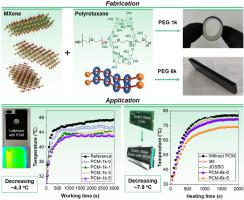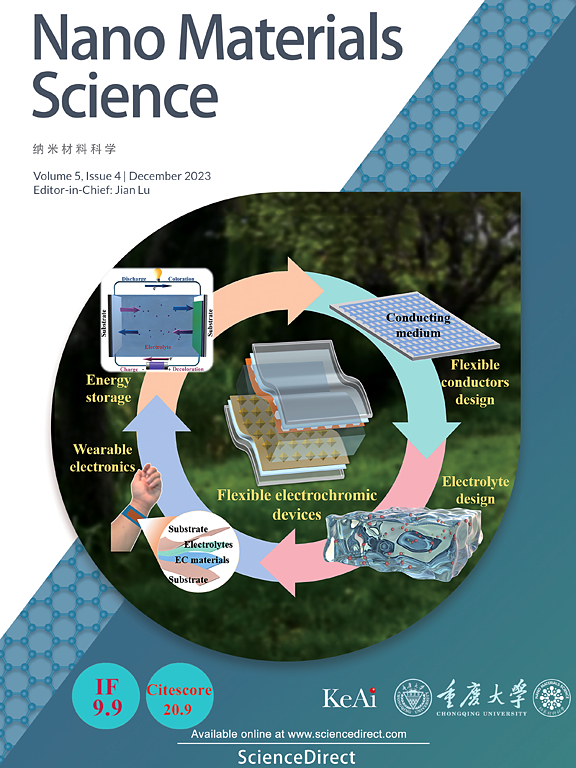MXene multi-functionalization of polyrotaxane based PCMs and the applications in electronic devices thermal management
IF 17.9
2区 材料科学
Q1 Engineering
引用次数: 0
Abstract
The aim of this work was to improve the thermal conductivity and electromagnetic shielding of the leakage proof phase change materials (PCMs), in which a polyrotaxane (PLR) was used as a support material to encapsulate PEG 1k or PEG 6k and MXene as multi-functional filler. The PCMs can be processed conveniently by a hot press and the PEG 1k containing samples showed excellent flexibility. We conducted a systematic evaluation of the phase transition behavior of the material, thermal conductivity and electromagnetic shielding performance tests. Notably, the PCMs achieved a high enthalpy values (123.9–159.6 J/g). The PCMs exhibited an increase of 44.3 %, and 137.5 % in thermal conductivity values with higher MXene content (5 wt%) for PLR-PEG6k and PLR-PEG1k, respectively, and show high shape stability and no leakage during and after phase transition. The introduction of MXene can significantly improve the electromagnetic shielding performance of PCM composites. Typically, higher conductive samples (samples which contain high MXene contents) offer a higher EMI SE shielding, reaching a maximum of 4.67 dB at 5.6 GHz for PLR-1K-MX5. These improvements solve the main problems of organic PEG based PCMs, thus making PLR-PEG-MXene based PCMs good candidates for thermoregulators of both solid-state disks and smart phone. It is worth pointing out that the sample PLR-1k-MX5 can decrease 4.3 °C of the reference temperature during cellphone running. Moreover, the temperature of the protecting sheet in the simulated solid state disk with PCM was significantly lower (showing a decreasing of 7.9 °C) compared with the blank sample.


基于聚二十六烷的 PCM 的 MXene 多功能化及其在电子设备热管理中的应用
这项研究的目的是提高防漏相变材料(PCMs)的导热性和电磁屏蔽性,其中使用了聚洛他赛(PLR)作为支撑材料,包裹 PEG 1k 或 PEG 6k,并使用 MXene 作为多功能填料。这种 PCM 可方便地通过热压工艺进行加工,含有 PEG 1k 的样品显示出极佳的柔韧性。我们对材料的相变行为、热导率和电磁屏蔽性能测试进行了系统评估。值得注意的是,PCM 达到了很高的焓值(123.9-159.6 J/g)。PLR-PEG6k 和 PLR-PEG1k 的 MXene 含量越高(5 wt%),PCM 的热导率值分别增加了 44.3% 和 137.5%,并且在相变过程中和相变后显示出较高的形状稳定性和无泄漏性。引入 MXene 可显著提高 PCM 复合材料的电磁屏蔽性能。通常情况下,导电性较高的样品(MXene 含量较高的样品)具有更高的电磁干扰屏蔽性能,PLR-1K-MX5 在 5.6 GHz 时的电磁干扰屏蔽性能最高可达 4.67 dB。这些改进解决了基于有机 PEG 的 PCM 的主要问题,从而使基于 PLR-PEG-MXene 的 PCM 成为固态磁盘和智能手机温度调节器的理想候选材料。值得注意的是,样品 PLR-1k-MX5 在手机运行过程中可将参考温度降低 4.3 °C。此外,与空白样品相比,含有 PCM 的模拟固态盘中保护片的温度明显降低(降低了 7.9 °C)。
本文章由计算机程序翻译,如有差异,请以英文原文为准。
求助全文
约1分钟内获得全文
求助全文
来源期刊

Nano Materials Science
Engineering-Mechanics of Materials
CiteScore
20.90
自引率
3.00%
发文量
294
审稿时长
9 weeks
期刊介绍:
Nano Materials Science (NMS) is an international and interdisciplinary, open access, scholarly journal. NMS publishes peer-reviewed original articles and reviews on nanoscale material science and nanometer devices, with topics encompassing preparation and processing; high-throughput characterization; material performance evaluation and application of material characteristics such as the microstructure and properties of one-dimensional, two-dimensional, and three-dimensional nanostructured and nanofunctional materials; design, preparation, and processing techniques; and performance evaluation technology and nanometer device applications.
 求助内容:
求助内容: 应助结果提醒方式:
应助结果提醒方式:


